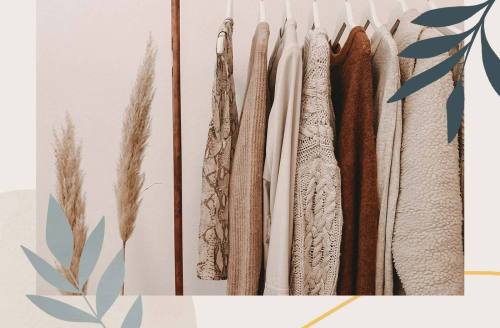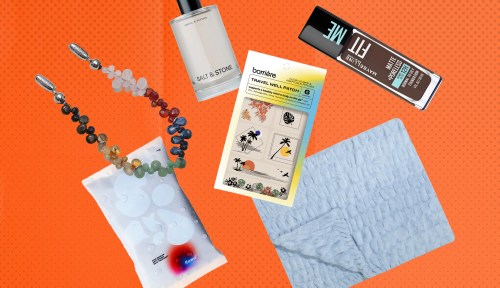I challenged myself to quit shopping for an entire year to benefit the environment—here’s what happened
Here's what happened when a writer went on a year-long shopping diet to fight against the climate crisis, and how to quit shopping for yourself.

Could you go without new clothes for a year? That was a question I was asking myself in late 2018, long before stay-at-home orders to stop the spread of the coronavirus pandemic effectively shrunk my wardrobe for me. Now, the answer feels like a no-brainer—surely I’m not the only person cycling between the same three to five outfits, largely made up of pajamas and athleisure. But a year and a half ago, when I first pondered it, that wasn’t the case. Back then, I was ruminating on the just-released report from the United Nations Intergovernmental Panel on Climate Change outlining how we had 12 years left (now 10) to drastically cut emissions before we’d face inevitable global environmental catastrophe and widespread extinction of many species. Figuring out how to quit shopping felt like a way I could help.
According to the United Nations Environment Programme (UNEP) and the Ellen MacArthur Foundation, the fashion industry is responsible for 10 percent of annual global carbon emissions (which is more than all international flights and maritime shipping combined). Plus, the average American reportedly buys 70 garments and wastes 81 pounds of clothing per year. Of course, individual changes alone won’t solve the climate crisis the way massive governmental intervention may, but every choice does matter in its own way by influencing public opinion and human behavior. So I decided to quit shopping and buy no new clothes or accessories for an entire year.
The challenge: How to quit shopping
The “shopping diet” rules were simple: Don’t buy new things. Repair existing items. For special occasions, “shop” from my closet or borrow from a friend. Though I considered renting clothes, I decided that, too, seemed wasteful when considering factors like cleaning measures and packaging materials.
On a daily basis, it was pretty easy to avoid shopping. I’d walk past stores without going in, feeling quite self-satisfied and even smug about my abstinence. Online, however, temptation lurked everywhere: via targeted-marketing algorithms pushing products my way, newsletters urgently promoting discounts, and some clever campaigns even framing shopping as a means of self care.
I quickly learned that when you stop shopping, the constant drumbeat to buy slows, then quiets, then disappears. The less I viewed, the less compelled I felt to shop at all.
To save myself from this digital minefield, I unsubscribed from e-commerce newsletters, unfollowed or muted Instagram accounts that triggered a shopping urge in me, and stopped reading fashion content covering the latest trends. Minimizing those messages recalibrated my spending momentum; I used to routinely buy without dedicating much thought, if any at all, to my need or use or intention for an item in question. I quickly learned, though, that when you stop shopping, the constant drumbeat to buy slows, then quiets, then disappears. The less I viewed, the less compelled I felt to shop at all.
The forced experience of shopping my closet
In the beginning of this experiment, I’d open my overstuffed closet in the morning and find “nothing to wear.” Without the excitement of something fresh to accent my older items, my outfit options felt lackluster and even frumpy—a feeling only heightened when I’d meet with friends or colleagues who somehow always seemed to look on-trend and polished. (Perhaps the lack of this ability amid social distancing guidelines is a factor exempting many of us from these feelings of outfit boredom.)
“The more you can extend the life and reinvent what you already own, the more you’re decreasing demand to produce faster, quicker, and ultimately disposable clothing.” —sustainable stylist Laura Madden
This was all in my head; sustainable fashion stylist Laura Madden says by rethinking what we currently have, most of us can breathe new life into the many garments already in our closets. “The more you can extend the life and reinvent what you already own, the more you’re decreasing demand—especially on the fast-fashion industry—to produce faster, quicker, and ultimately disposable clothing,” she says. “A lot of times, it just takes another set of eyes to put two pieces together in a totally different way. That feels fresh and exciting, and it gives you that dopamine rush of having something ‘new.'”
Furthermore, when I looped in others about my plan, I only received support and like-minded enthusiasm in return. A couple of style influencer friends even confided that they had been feeling conflicted about showcasing new outfits, and that they were starting to encourage their followers to buy vintage instead of new. Still, though, novelty remained a difficult urge to resist, and I’d sometimes wish I could update my closet, even just a little bit.
Ultimately, I did. I wanted to make it through a full year without buying anything new, but in the spring of 2019, I discovered that my black cashmere sweater had been devoured by hungry moths. The garment served me well for 10 years, so I replaced it with one for the next decade. In May, I had to buy a new swimsuit because my existing ones no longer fit. And on December 31, while on an overnight trip for which I’d packed just enough for the next day, I had to rush to the Gap sale rack to buy an emergency dress and pair of underpants. (I’ll spare you the details.)
Otherwise, though, I succumbed to the occasional consignment-store item: A pair of unworn Gucci loafers from the ’80s, a form-fitting dress, a new-with-tags blouse, and a pair of sandals. Madden advises that when you do buy items, it’s best to ask yourself practical questions to make sure you’re doing so thoughtfully: How frequently will you wear the item? Can you mix and match it with your existing wardrobe? Does something you already own meet the same needs? And though I was satisfied with my answers to the questions in all cases of “cheating,” the transactions didn’t feel as exciting as I assumed they would. In fact, they were downright anti-climactic.
The results
Though I didn’t play by the rules to perfection, I did emerge from the experiment differently than I came in. I no longer cared about trends, and I wound up saving hundreds (thousands, maybe?) of dollars. Then, after a massive Kondo-style closet clean-out, I sold my other unwanted clothes to a local secondhand store, making even more. The exercise wasn’t financially driven, though; rather, by streamlining my wardrobe, I got a better sense of my own style, which gifted me a sense of ease and simplicity in getting dressed each morning. Ultimately I wound up with more money, less stress, and less climate anxiety.
As of March, I haven’t bought any clothes or accessories (new or secondhand) in 2020. Simply put, my habits have shifted in a way that makes me happier. Knowing my personal taste now stops me from buying what I don’t need and even makes shopping feel less exciting—which, to be clear, I feel is a win. It’s priceless to me to not desire to buy new things, to feel that I have enough—that I am enough—without a stream of fresh outfits. And while that alone won’t solve the climate crisis, it is a productive, even though infinitesimally so, piece of a necessary collective effort that I can feel great about.
Sign up for the Well+Good SHOP Newsletter
Get exclusive deals on wellness, beauty, fitness, and food products that have been hand-picked by our editors.
Got it, you've been added to our email list.










